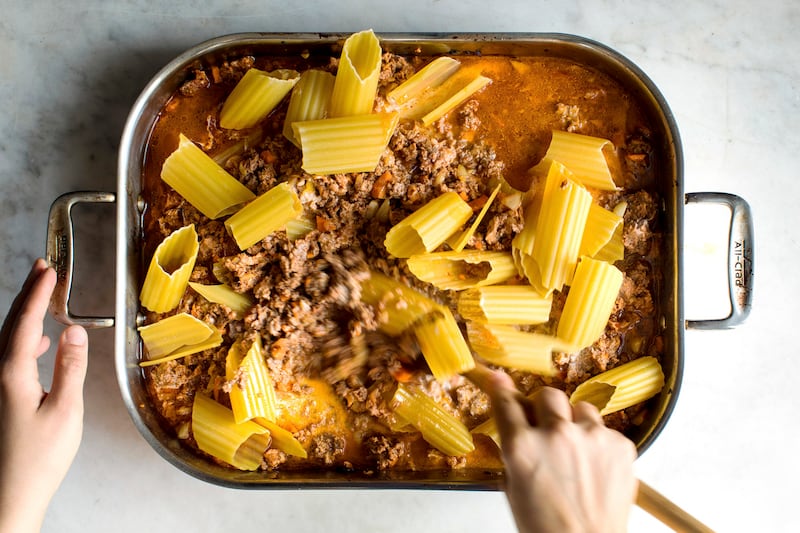It’s 7pm, and dinner is on the table: a large, one-dish centerpiece for everyone to dig into. We call it a one-pot wonder for a good reason, and that is its incredible ability to connect ingredients and humans alike. Centuries of cooking in underground pits or stone-built hearths have shaped our instincts to both get together and throw it all together.
My experience writing recipes definitely confirms this: one-pan dishes are by far the most popular. The sense of contentment people experience when they gather around one is akin to the comfort they get when they taste it. Ingredients that have been left to sit alongside one another for a long while simply lose some of their sharp edges for the sake of a greater good, in much the same way as individuals morph into a family.
Something else is at play here, I suspect, something much more prosaic: cleaning up. Modern-day cooking and feeding are wedged between a host of other activities that make up our busy schedules. Skipping a couple of extra saucepans and serving straight from the pot is attractive proposition for those strapped for time.

This will bring out the crowds in the way that pasta dishes always do, but the tools are, more or less, as old as time: heat, a vessel and one hungry cook
All this doesn’t mean, however, that one-pot cooking is necessarily simple or easy (although it definitely can be). Putting all your ingredients in one dish might seem like a short cut for a more complicated approach. But, in reality, I find that to create the flavour and texture bombs that make food delicious you are often required to break down the process, adding components at different stages, playing with temperatures or scattering a garnish or salsa over the top at the end.
This works particularly well when you use a roasting tin as your vessel. The large surface area allows you to stir, crush, broil or garnish your dish more effectively, and makes it look so much better.
For all these reasons, 2019 is shaping up to be my dinner-cooked-in-a-roasting-tin year. The first attempt has already yielded a magical surprise. In a single pan I made a ragout that would normally take a few watchful hours on the stove; as a bonus, the pasta cooks in the sauce as it becomes thicker and richer.
The result will bring out the crowds in the way that pasta dishes always do, but the tools are, more or less, as old as time: heat, a vessel and one hungry cook.
ONE-PAN PASTA WITH HARISSA BOLOGNESE
Serves six
90-minute cooking time, plus cooling time

Ingredients
675g beef mince, at least 15 per cent fat
450g pork mince
90g tomato puree
70g harissa paste
2tbsp Worcestershire sauce
1tbsp ground cumin
1tbsp ground coriander
80ml olive oil
60g Parmesan, finely grated
60g Pecorino Romano, finely grated
Salt and black pepper
1 carrot, peeled, halved lengthways and sliced
1 small onion, peeled and roughly chopped
2 large plum tomatoes, roughly chopped
4 garlic cloves, peeled and roughly chopped
750ml chicken stock
100ml double cream
225g dried manicotti or cannelloni pasta, roughly chopped in half crossways
10g roughly chopped parsley, plus extra for garnish
Method
Step 1 Heat oven to 245 Celsius. Add the first seven ingredients to a large roasting tin about 38cm by 23cm in size, along with three tablespoons of oil, about two-thirds of the Parmesan and Pecorino Romano, 1¾ teaspoons of salt and plenty of pepper.
Step 2 Add the carrot, onion, tomatoes and garlic to a food processor and blitz until finely chopped. Add to the roasting tin and mix to combine. Transfer to the oven and bake until browned on top and sizzling – about 25 minutes. Reduce heat to 190 Celsius.
Step 3 Use a fork to break the meat apart thoroughly, stirring it into the liquid that has been produced. Pour the chicken stock and cream on top, then add the pasta. Stir the pasta into the sauce until thoroughly coated; you want to get all of the pasta wet so it doesn't burn. Push as much of the pasta under the surface of the sauce as possible. (You won't be able to submerge it all.)
Step 4 Bake until pasta is tender – about 25 minutes – stirring halfway through cooking.
Step 5 Remove from the oven, stir in the 10g of parsley, sprinkle with the remaining Parmesan and Pecorino Romano and drizzle with the remaining oil. Bake until the top is crisp in parts and beginning to brown – about eight minutes. Sprinkle with some additional parsley and let cool for 10 minutes, so the excess liquid soaks in, before serving. – New York Times












